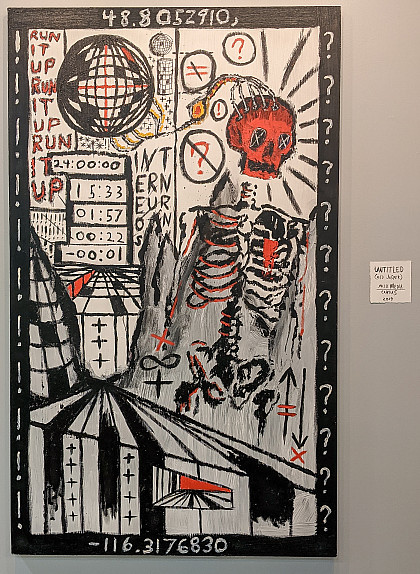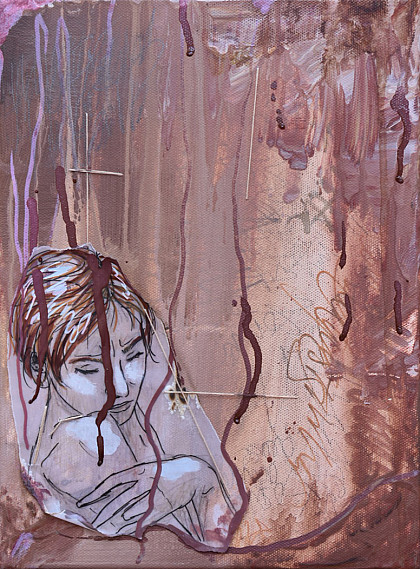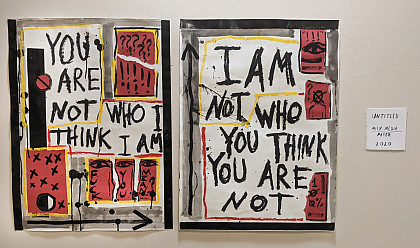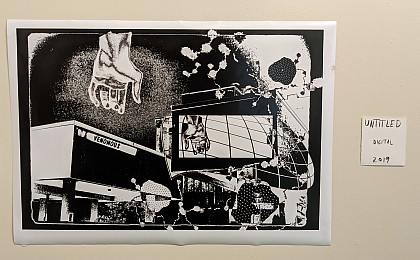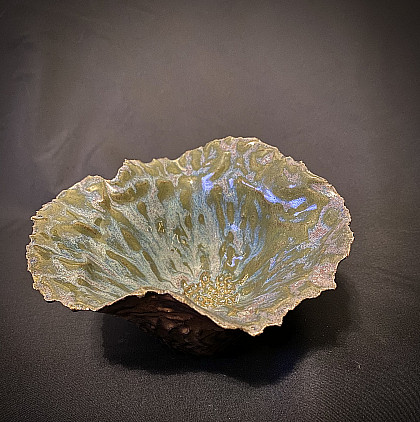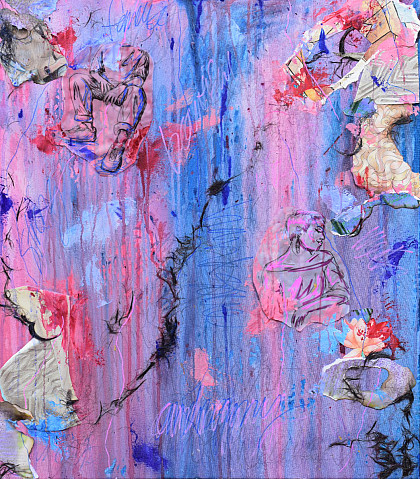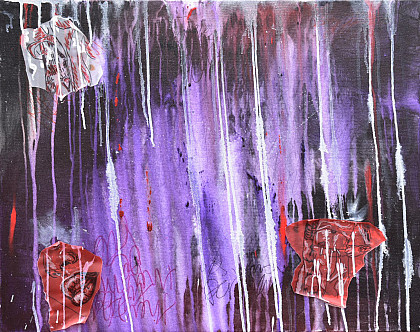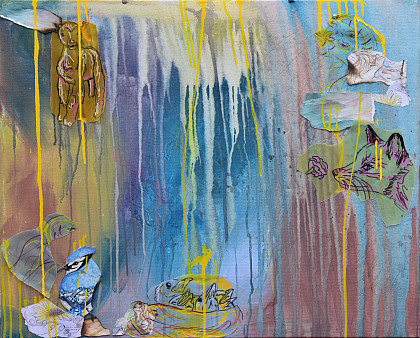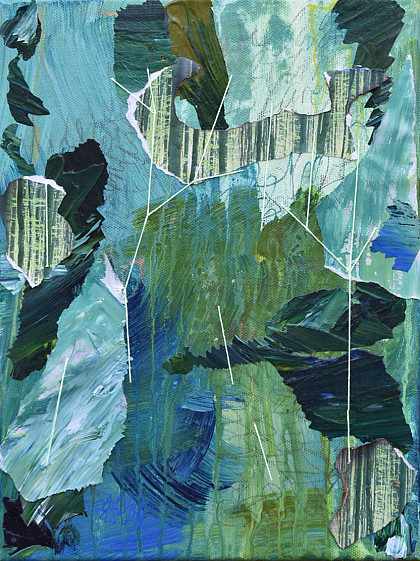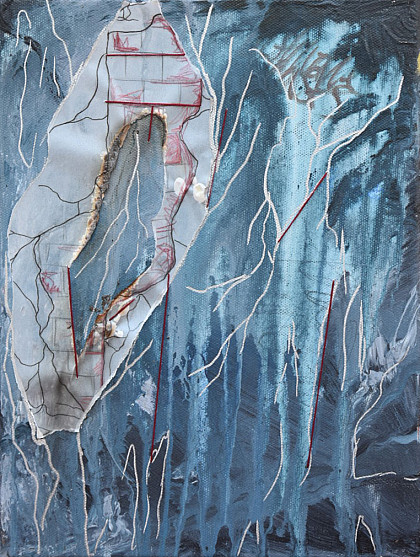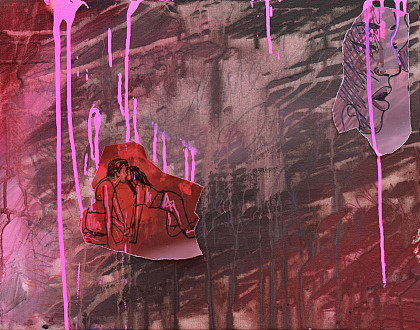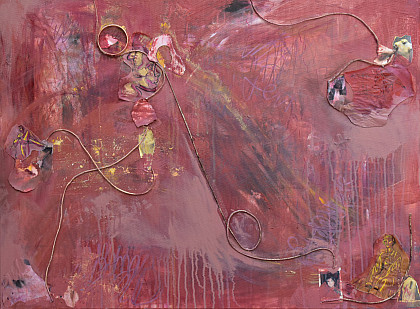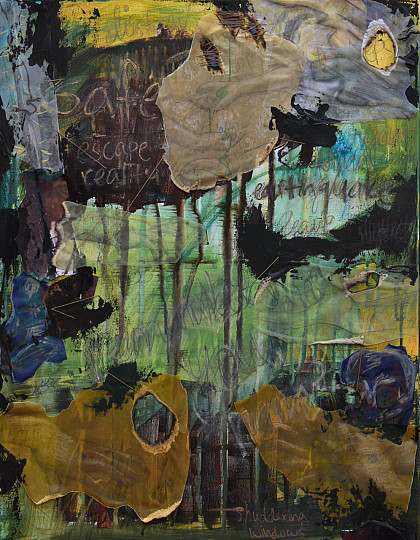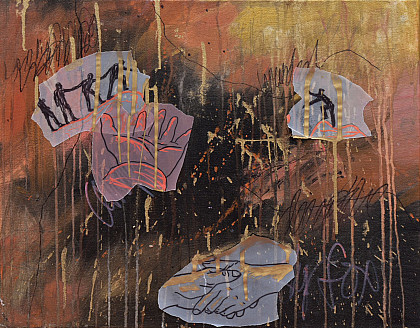Student Exhibition
Student Exhibitions
- Liam Besneatte-Cullinane, Untitled, mixed media
- Shay Reynolds, Pixie Dust 4, acrylic, graphite, pen, and thread on canvas
-
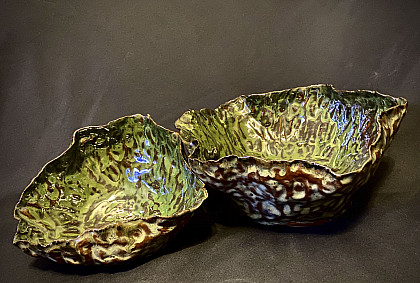 Michelle Barnette, J57, 2020, Ceramic
Michelle Barnette, J57, 2020, Ceramic -
 Dustin Ernest, Project Yourself, archival inkjet print
Dustin Ernest, Project Yourself, archival inkjet print -
 Ellen Hicks, Dismantled, oil on canvas
Ellen Hicks, Dismantled, oil on canvas -
 Theresa Mitten, Rise, mixed media
Theresa Mitten, Rise, mixed media -
 Hannah Muller, Stuck (detail), ceramic and pins
Hannah Muller, Stuck (detail), ceramic and pins -
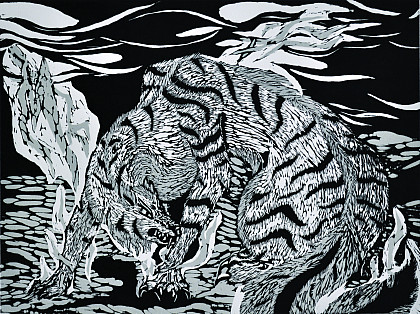 Chelsea Snead, Raging Raiju, two-color relief print
Chelsea Snead, Raging Raiju, two-color relief print -
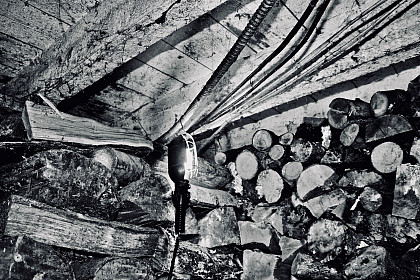 Roggy, archival pigment print, 11” x 19”, 2019
Roggy, archival pigment print, 11” x 19”, 2019 -
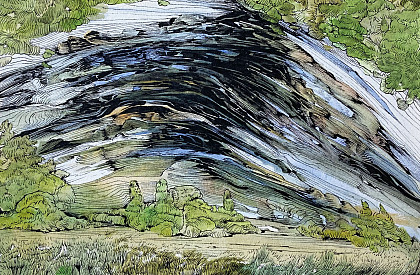 Devils Backbone, watercolor and ink, 7.5” X 11.25”, 2021
Devils Backbone, watercolor and ink, 7.5” X 11.25”, 2021
Emory & Henry Art Department Student Exhibitions
About
Visual art students at Emory & Henry display a rare creative and entrepreneurial spirit that starts with a unique hands-on approach to learning from our award-winning faculty. This expertise carries on long after graduation and into the professional world. Each individual explores a rich array of approaches toward creating while investing original ideas through painting, drawing, photography, collage, graphic design, printmaking, ceramics, sculpture, mixed media, and any number of combinations of art-making techniques.
We are proud to present their research at the McGlothlin Center for the Arts.
Spring 2023 Exhibiting Artists
-

Veronica Garrou
Keep readingMy work is focused around two topics – diverse storytelling and representation. Diverse storytelling is important to me as an artist because it provides a platform to share a range of narratives and shows that there is value in an array of experiences and perspectives. More specifically, storytelling focuses on circumstance, curiosity, characters, conversations, and conflicts. I want my show to embody these elements of storytelling through a diverse array of settings, characters, and conflicts, while presenting them in a format that would promote curiosity. I chose comic book covers because in this medium the cover art and layout are important in creating curiosity in the audience. Without a strong cover, it is unlikely a consumer would think to pick up a comic no matter the story being told inside.
The next topic my work focuses on is representation. When thinking about representation in my work I think there are three main ideas that are important. The first is that an individual can, if they try, connect to any character. More specifically, a character does not have to be an exact copy of an individual in terms of how you identify for you to connect to them. It is more the shared experiences that bind us. The second is that in modern media representation and in turn how you identify has become something that needs to be announced.But in reality a person’s sexuality, gender and race are more nuanced. One cannot know these specific things just by viewing someone’s presentation. This is present in my show through gender. I tried to present some characters as more neutral and in my feedback I have found many people see them as different genders. Lastly, I believe that the media needs to present characters and tell their stories without pigeonholing them according to their unique differences. This is why I tried to present a range of characters partaking in a range of experiences.
My work is meant to tell a range of stories and present an array of characters. My work exudes a sense of vibrant intrigue. Much like the media that inspires me it is unapologetic. I seek for my work to inspire others to create.
-

Josh Levy
Keep readingIn my work I like to capture the emotions and essence of people and artists I admire and am inspired by. I listen to music most of the time while working and try to immortalize the feeling of the music in every work, and I have been drawn to these influences for a while now, even if I do not fully understand why. Furthermore, I work mainly with acrylic and oil paints on canvas and wood panel, and intaglio and aquatint printmaking. When it is appropriate, I also enjoy incorporating embroidery into my work, usually with beading.
Additionally, I am influenced by many queer and queer-supporting artists. I could only make art of people if I am sure that they love and support this community and everyone in it. Similarly, my artwork tends to gravitate towards figures of women. I love the strength of women and how they fight for their voices in a patriarchal society that tries to push them down and silence them. I do not necessarily feel like I, as a male identifying person, need to speak for the women that I paint, but I want to thank them for how they make me feel through their work, and their support for others.
Furthermore, color is one of the most prominent assets in my work and I try to make my color choices intentional and impactful. If one of my works is more solemn or more angry, peaceful or stressed, I want it to be perceivable in the color palette I have chosen. I never want somebody to be bored with what they see when they walk past one of my works. I want the colors to pull them in so they can see the details in the work up close.
-

Delaney Love
Keep readingThere are many little memories that come to the forefront of one’s mind that are triggered by certain objects, smells, and even past events. Who would I be if I had not realized at the age of 10 sitting in my southern Baptist church that organized religion did not make sense to me? It seems to be a reminder every time I hear church bells, the smell of the air in the sanctuary, and the Sunday school class that shared gummies as a snack. For as long as I can remember I have loved researching the ideas of other religions and how the United States population sees it.
My relief prints are the production of years of wondering if there is a god. Could there be more than one? Why do we have to have one true religion in the world? Some people today do not fully respect the practices of others’ religions. Without the knowledge of these beliefs, the next generation but just the same. I choose relief print because in this medium can be molded to add my artistic style into it . Every piece in this collection utilizes gold leaf sheets; I chose this material because it gives the viewer something to decipher.
Through my research of these religions there is a creation of understanding of the lives of the people that follow them. My work is meant to tell a variety of stories with different points of view about multiple religions. The work that has been made is meant to inspire and bring forth an understanding of others and give hope to others to create.
Most of us are told that we should respect everyone’s opinion, so why can’t we respect that others may have different views than us?
-

Tara Sanders
Keep readingThe human experience is a topic that has always fascinated me, specifically the way we interact with each other, ourselves and technology. With the introduction of social media, there has been a cultural shift amongst human beings and the way we communicate with each other; especially given how media surrounds our daily lives. The long-term effects of media consumption is something that affects everyone who uses it, and my art brings awareness to this social problem. While the specific struggles vary from piece to piece, the common denominator is media, its purpose, and how it is used recreationally. My designs and illustrations explore sensitive subjects with bold graphics, an explosion of color, calligraphic lines, and shape.
I create my art with programs such as Procreate, Adobe Photoshop, and Adobe InDesign. My favorite traditional form of art to explore is paper collage, and I like to obtain my graphics from magazines and newspapers. My favorite element in my work is color because of its richness in symbolism, as well as how it interacts with viewers. Everyone sees color differently, yet we also see it similarly. The colors I’m drawn to in my work are meaningful to the subject within the work, but can also be up for interpretation, as color affects everyone differently.
I draw inspiration for my art from personal experiences as well as from peers. Although the generation before mine was the first to be exposed to social media and use it as the primary form of communicating, my generation has been gifted vices such as insecurity and mental health struggles on a silver platter, which can have life altering consequences.
-

Olivia Strouth
Keep readingI grew up admiring both printed comics and animated cartoons, longing for my work to be fully realized as a famous piece of media with rich storytelling, captivating designs, and heavy-hitting plotlines. Over the years, my art has developed into a darkly comedic, semi-realistic style, crafting anatomically plausible characters using digital mediums. I thoroughly enjoy bringing my imagination into the fringes of reality to interact in both fantastical and domestic situations.
One of the most noticeable parts of my characters is that they are unsettling, uncanny humanoid figures. These creatures navigate the pressures of conformity in different manners, representing the range of human experiences and individuality. Some have grown up and lost what makes them special, while others struggle to find their place in the world. How will they be allowed to feel human emotion while being viewed as something inhuman or evil? I ask myself this question every time I write about my art.
I am drawn, fervently, to seek understanding. My characters, beloved extensions of me, have been developed to tackle specific problems such as platonic relationships, navigating “embarrassing” personal interests, mental health and more. Each piece of art in this show partakes in the theme of overcoming problems as a group, aiming to conclude with the outcome of least pain. I know there will be sacrifices, and so do they. Reality and fantasy are richest when there are obstacles to overcome and a great, looming, impassable beast blocks their paths. May they work together and bring the truth to the surface regardless of who is left behind.
-

Sarah Thomas
Keep readingFor most of my life, I have battled several mental illnesses. I have witnessed first-hand what others have faced and would like to spread more awareness of this topic through imagery. My work focuses on exploring deep meanings through psychology and bringing awareness to mental illnesses such as anxiety, depression and the process of recovery. I have always found interest in learning about how the mind works and what makes us who we are. This series was created through the combination of two of my favorite interests, art and psychology. Through my work, I am discovering and creating more ways to help bring more awareness to the severity and reality of mental illnesses.
My exhibition was created to help others better understand the lives of people who struggle with mental illnesses. Each design depicts one of nine mental illnesses or negative thoughts and emotions. There are six that cover seeking treatment and the process of recovery. With these designs, I hope to bring more awareness to the severity and reality of what people who battle with a mental illness face.
The primary medium I work with is digital design using the programs InDesign and Illustrator. In Illustrator, the imagery is created and then placed into InDesign with the already graphed out typography. To help make the typography and imagery harmonize, I design a specific background to match the meaning of the type and the energy of the image. Once the designs are complete, they are printed as archival pigment prints. Within this series, there are fifteen digital posters and an informational card for each poster. I chose this medium because it not only brings awareness to people who attend my show – the viewers are capable of spreading awareness through the distribution of the informational cards as well. For example, someone who visits my show can pick up one of the informational cards and spread more awareness outside of the show to a larger audience. This was the primary reason I chose digital design as the medium of my work. Digital design and typography are inspiring to work with and help me express my true emotions to a wide range of viewers.
-

Tommy Tomlin
Keep readingOur bodies are wired to remember, we retain information long after something has come to pass. That’s why smelling hot sawdust takes me back to my father’s construction sites and the Saturdays we would spend checking on each one, why the scar on my forehead brings me back to thinking I was going to die from a superficial cut. Who would I be had not tromped through the woods with my cousins at age five, ruining our tennis shoes in the mud and catching salamanders? The dark depths that these memories emerge from is much like the ocean. With the full picture never truly there, I find myself remembering small details that were important to me at the time. The moment I recall something, it seems like one hundred other moments burst forth into my consciousness, like an overpacked sardine tin being opened.
Using collage, I can bring elements from all over and stitch them together into a cohesive idea. It doesn’t stop at scraps of paper and glue, as digital art programs help in adding depth, light, and shadow, ultimately creating something beyond the original pieces. I believe we aren’t just the products of situation, but the pieces and parts of things we stitch together to create one’s view of the world. Using fish, sardines, grants an anonymity to each memory to allow more focus on the emotion versus the person.
Reflecting on the good and bad of my childhood allows me to reconcile with my younger self and ultimately heal and understand why I am the way I am as an adult. Sometimes I wonder if I’ll always be that little kid, facing trials and tribulations over and over again, unsure of myself and the world. As I grow and allow myself to look back, I realize I can handle the hardships of life and that younger me was stronger than I could ever imagine.
Spring 2022 Exhibiting Artists
-

Mary Chura
Keep readingAs a young girl I began drawing -terrible frankly, little horse sketches in the margins of my notebooks. Eventually, I found a how-to guide for drawing horses and other animals, and eventually I moved on to other beloved animals and then to landscapes and scenery around me. Nature themes remain prevalent in my work, and animals have always remained a common subject. I enjoy recreating natural environments to which I’ve been witness, giving them an illustrative feeling through my use of line. My pieces often utilize detailed line work and a variety of line weights working together within a composition.
To me reality exists, even if you decide to stop believing in it. Things we imagine or create may yield to our desires, but reality is stubborn. When I depict subjects that are not realistically scaled or utilize symbols, I am creating something that is to me surreal because these things exist within my imagination and fulfill my desire to emphasize nature. I often mesh surreal elements such as large, scaled plants, animals or faunal remains with a natural landscape. Natural landscapes and symbols are appealing to me because I have always felt drawn to exploring nature. I believe that humans are most connected to themselves when they are connected to nature. Connection to the natural world is one of the most important parts of the human experience to me, and I believe that by depicting aspects of nature as larger than life I am emphasizing the importance of nature to the viewer.
I enjoy depicting humans as well, particularly faces, as I am interested in emotions such as grief, sadness and curiosity and how they can connect us to each other and our environment. When I depict human beings within my pieces they often are not based on anatomical correctness or striving to look realistic, rather they have illustrative elements such as waving lines meant to convey an emotion or atmosphere. Drawing gives me a place to alter my reality and recreate it as a tangible piece. I often use a semi realistic landscape as a starting point and recreate it with new elements that I feel intensify it, such as large, scaled subjects or symbols that have personal meaning. I use the same approach with my depictions of humans, a realistic starting point with added elements such as lines to create an emotion and feeling I want the viewer to understand.
-

Lorin Zehr
Keep readingThe idea that everything must come to an end has always been one that has always fascinated me, that one day you will set something down and never pick it up again, that somethings
Spring 2021 Exhibiting Artists
-
Liam Besneatte-Cullinane
Keep readingMy work exists as an intersection between my brain and others’. I am fascinated by the self-contained, distinct reality that exists within every person’s mind. This has led me to fully devote my efforts to understanding the ontology of thought, i.e. what thought is, what can be said of the existence or nature of thought, how thought can or cannot be categorized. In my current body of work, my research has been focused on the scientific nature of thought development through biology, psychology, and anatomy, as well as the philosophical implications of thought; human identity, instinct vs. socialized nature, and epistemology, the study of knowledge itself. Thought is the defining feature of our human species, and there is no consensus as to how it is defined or understood. My goal is to understand everything I can, share this, and compel others to do the same.
My art making practice is fully intuitive. While I may spend weeks developing a concept or researching a topic, the physical act of making is fast, gestural, and instinctual. My choices of media are dictated by availability and cohesion with the form of the artwork in my mind. Repeated motifs in my current body of work include ink splatters reminiscent of biological processes, collage using scientific or wartime imagery, harsh and emotive lines, abstracted language and impossible perspectives.
I aim to create a distinct, surreal, existential mental landscape in the mind of my viewer. It is my hope that within this illusionary space, viewers are forced to experience ideas that compel them to introspection and extrospection - and this area, between the mind and the world, is where I find myself the most at home.
Liam Besneatte-Culliane
-
Untitled (Red Jasper), mixed media, 2019
-
Untitled, mixed media, 2019
-
Untitled, mixed media paper, 2020
-
Untitled, mixed media plywood, 2019
-
Untitled, digital, 2019
-
Untitled, mixed media plywood, 2020
Biography
Liam Besneatte-Cullinane is a multimedia artist currently attending Emory & Henry college. Cullinane was born in northern Idaho in 1997, and at a young age moved from the west coast to northeast Tennessee where they still live. Homeschooled until college age, Cullinane was able to develop their creativity and curiosity freely as a child; they often abandoned their schoolwork to explore the forest, natural science books, and their own imagination.
Cullinane’s current body of work examines cognition, the mind in empirical and rationalist contexts, epistemology of the human condition, and inductive research about what it means to have thoughts. This project primarily employs mixed-media as a medium, and is characterized by deconstructed and anti-formalist composition and mark making. Cullinane aims to communicate their theses through emotive, illusionary, and compelling imagery.
Since September 2017, Cullinane has been employed at the McGlothlin Center for the Arts where he currently holds the position of assistant curator. In this role, Cullinane has been directly involved in the design, production, hanging, and attending of over twenty professional gallery shows.
Cullinane is the vice president of service fraternity Theta Chi Epsilon, and president of the Student Art Association. They were awarded the Emily Williams award in 2019, given to only one Junior at Emory & Henry per year, which provides a fully paid summer study program in the United Kingdom, and also receives an annual Art Department scholarship.
Cullinane’s hobbies include driving his ’95 Ford Explorer through the mountains, listening to hip-hop, and philosophical talks with friends.
-
Fall 2020 Exhibiting Artists
-

Michelle Barnette
Keep readingThis show is titled Beautiful, Unique, Fragile. This collection consists of pinch pots made from brown stone clay with a glaze. These pinch pots are created to be very organic forms. They represent me as a person in the way I see myself. I as an artist am very, “go with the flow” and tend to not really plan out what I’m going to create. My work is a way for me to cope with the world around me. The way this works for me is that I go to the art studio after everyone is gone and sit with either music or my favorite movies on, accompany that with a snack and I just let my hands work with the clay. It’s very calming to press into the clay and watch as my hands begin to create. A small pot takes shape as I pinch around the sides much like my love for the form. I allow myself to work with the clay letting it react how it wants to with the way I press it between my fingers. When I pinch I try to leave fingerprints in the clay to leave it with a finish that shows it has been touched. This is a way of me showing that I am just a ball of clay reacting to the way the world around me presses me and forms me into the person I am today. When I glaze the fired pots I choose glazes that have either a smooth glassy texture or a satin finish. I want the pots to be handled. They are meant to be used and have a function in life. I as a person have a function and have purpose in this life. I let that reflect in my work. As well as taking into account the finish of the glaze I try to make sure to use glaze that is 100% food safe. Along with being useful and functional, my pinch pots are fragile and can break but not as easy as glass. They are resilient to some of what the world throws at them but they do have a breaking point just as I do as a person. I wanted to create works that capture me as an artist but not have it be completely blatant to the viewer. My works are named with random letters or numbers. I don’t want the viewer to be told what to feel by a name for my works. I want them to take the works as they are. They are beautiful, unique, and fragile.
-
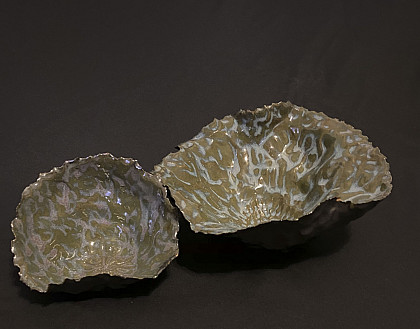 Michelle Barnette, B2, 2020, Ceramic
Michelle Barnette, B2, 2020, Ceramic -
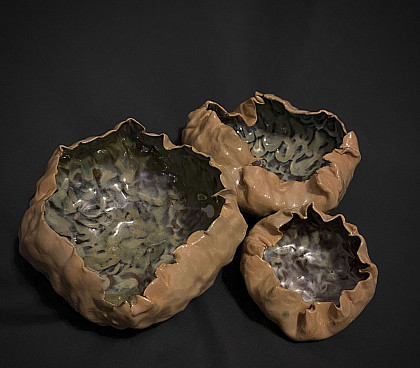 Michelle Barnette, CRD1, 2020, Ceramic
Michelle Barnette, CRD1, 2020, Ceramic -
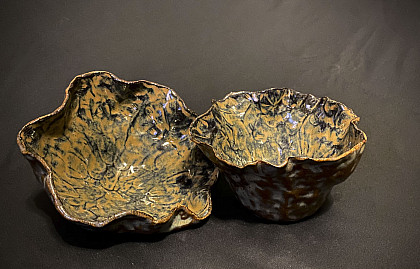 Michelle Barnette, G7, 2020, Ceramic
Michelle Barnette, G7, 2020, Ceramic -
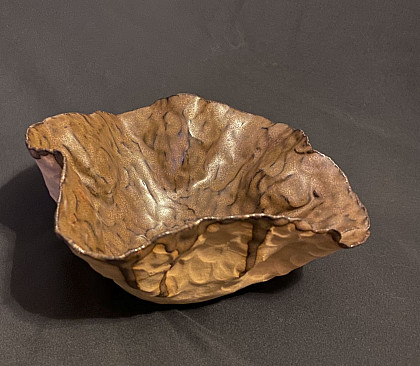 Michelle Barnette, F66, 2020, Ceramic
Michelle Barnette, F66, 2020, Ceramic -
 Michelle Barnette, J57, 2020, Ceramic
Michelle Barnette, J57, 2020, Ceramic -
 Michelle Barnette, M3, 2020, Ceramic
Michelle Barnette, M3, 2020, Ceramic -
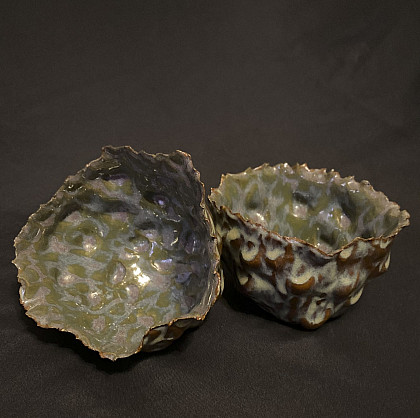 Michelle Barnette, P15, 2020, Ceramic
Michelle Barnette, P15, 2020, Ceramic -
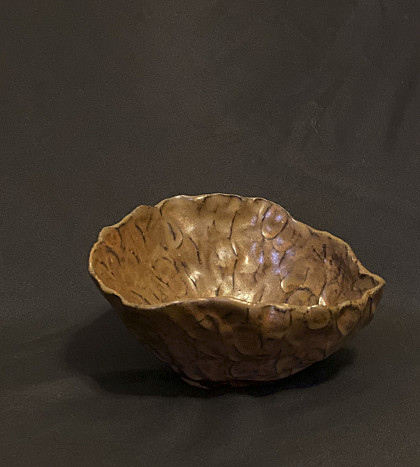 Michelle Barnette, R5, 2020, Ceramic
Michelle Barnette, R5, 2020, Ceramic -
Michelle Barnette, S45, 2020, Ceramic
-
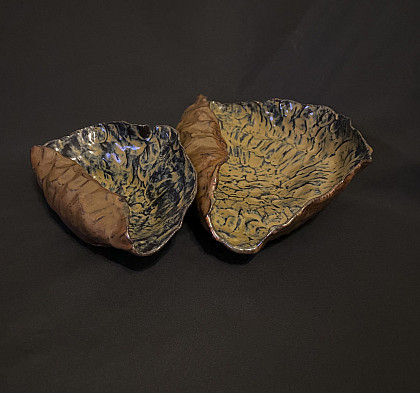 Michelle Barnette, T13, 2020, Ceramic
Michelle Barnette, T13, 2020, Ceramic -
 Michelle Barnette, W6, 2020, Ceramic
Michelle Barnette, W6, 2020, Ceramic -
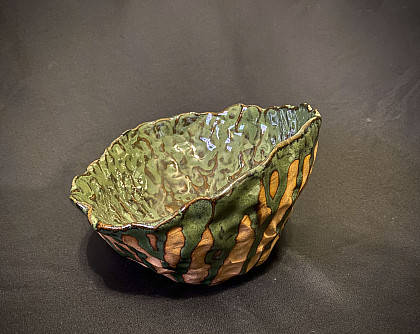 Michelle Barnette, X99, 2020, Ceramic
Michelle Barnette, X99, 2020, Ceramic -
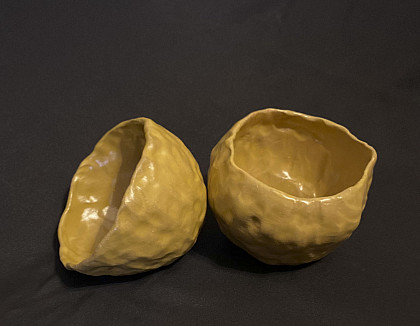 Michelle Barnette, Y21, 2020, Ceramic
Michelle Barnette, Y21, 2020, Ceramic -
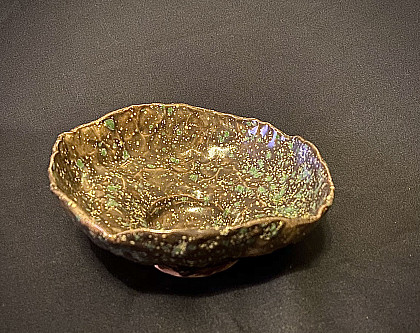 Michelle Barnett, Z30, 2020, Ceramic
Michelle Barnett, Z30, 2020, Ceramic
Photo Album: Michelle Barnette
Biography
Michelle is a Mixed Media Crafts Artist studying at Emory & Henry College. She was born in Charlotte, North Carolina where she was adopted by her amazing parents Paul and Mary Barnette. As a child, Michelle was always smiling and singing. She was a truly happy child. She wanted to try most all things, clubs and teams but she never seemed to hold onto one specific talent. As she grew, she became more interested in Art and Culinary. Michelle’s family has moved a lot during her life. She has never truly been in one place for very long until they built their dream farm in Abingdon, Virginia. This is where she finished middle school and high school. Michelle attended Abingdon High School and graduated in 2016. It was here that she was given the opportunity to take Culinary Arts. Michelle completely fell in love with this and even participated and won state championships. Michelle was also given the opportunity to have some of the best art teachers while in middle and high school. This is when she truly fell in love with Art and decided to choose that as a career path and move forward with higher education. She first attended Virginia Highlands Community college for two years and then transferred to Emory & Henry. It was here that she was blessed to be able to study under some amazing Art professors and given more opportunities than she could imagine. The highlight of while attending Emory & Henry was when she attended the study abroad trip to Italy for 14 days. Michelle fell in love with ceramics after taking ceramics in high school but when she took it with Professor Remmen she knew that it was truly her passion. Michelle has had a lot of ups and downs in her personal life and this has truly shaped her into the artist she has become today. She has used Ceramics and Art as a coping skill with the daily troubles she faces. Michelle is a beautiful, unique and fragile person but with all the troubles she has faced it has been like firings for clay. She has become stronger through the heat and more resilient with every polishing, just as clay does when fired and glazed.
-
-
Adrianna “Shay” Reynolds
Keep reading“I exist as I am, that is enough, / If no other in the world be aware I sit content, / And if each and all be aware I sit content.” – Walt Whitman’s “Song of Myself”
In a generation full of defining labels, it can be difficult to find the truth behind who you are. Many Americans are made to believe that people are unique in our own ways, an individual. Yet if someone “chooses” the wrong identity, shunning or disowning are the most passive responses. Therefore, some people hide our truth, as I do.I create collages with acrylic paint and graphite on canvas with various materials ranging from vellum paper to glass or twine. These collages explore what the meanings of the words identity, human, hidden, acceptance, and reflection mean to me. As I struggle to find my identity, I consistently write in quotes, lyrics, poetry, or significant words to create art based on these streams of consciousness. These words written with graphite or pen represent deeply ingrained anxieties about my journey to acceptance and self-love. The underlying abstract imagery plays with the psychological meaning, or suggestion of specific feelings, of colors while the descriptive imagery shows my visual manifestation of these feelings and traits. These layers of abstraction and description represent my experiences, feelings, and meditations that build onto one another to create myself.
Becoming comfortable with this idea of revealing my identity is something I have spent close to all of my life attempting to accomplish. Assumptions based on whom I was born as versus whom I have chosen to become has confronted me with a daunting question, “Do I have the right to be who I am?” These judgments and labels cause relentless anxieties of rejection, so I bury much of my evolving identity below the surface, only seen by those I trust intimately. I conceal my true self in front of disapproving eyes, but in safety, I am a completely different person. Truthfully, I am an androgynous, asexual person who prefers comfortability and personality as opposed to beauty and physicality.
My work focuses on the process of seeking rather than the product. They are the archives of my journey. It is a long process, but a necessary one to feel comfortable deviating away from permanence towards my honest identity.
-
Shay Reynolds, Artery, February 2020, 22” x 28”, acrylic, graphite, paper, thread, and chalk pastels on canvas
-
Shay Reynolds, Between, May 2020, 30” x 24”, acrylic, graphite, hair, pen, and paper on canvas
-
Shay Reynolds, Conform, May 2020, 24” x 30”, acrylic, graphite, pen, and paper on canvas
-
Shay Reynolds, Cozy, May 2020, 24” x 30”, acrylic, watercolor, graphite, pen, and paper on canvas
-
Shay Reynolds, Faith, February 2020, 30” x 40”, acrylic, graphite, paper, and thread on canvas
-
Shay Reynolds, Monotone, April 2020, 20” x 16”, acrylic, graphite, cardboard, pen, and paper on canvas
-
Shay Reynolds, Pixie Dust 1, April 2020, 12” x 9”, acrylic, graphite, and thread on canvas
-
Shay Reynolds, Pixie Dust 2, April 2020, 12” x 9”, acrylic, graphite, and thread on canvas
-
Shay Reynolds, Pixie Dust 3, April 2020, 12” x 9”, acrylic, graphite, pen, and thread on canvas
-
Shay Reynolds, Pixie Dust 4, April 2020, 12” x 9”, acrylic, graphite, pen, and thread on canvas
-
Shay Reynolds, Pursuit, May 2020, 16” x 20”, acrylic, graphite, pen, and paper on canvas
-
Shay Reynolds, Seductress, March 2020, 30” x 40”, acrylic, graphite, paper, glass, twine, and pen on canvas
-
Shay Reynolds, Stitches, February 2020, 22” x 28”, acrylic, graphite, paper, thread, and chalk pastels on canvas
-
Shay Reynolds, Trust, May 2020, 16” x 20”, acrylic, graphite, pen, and paper on canvas
Photo Album: Shay Reynolds
Biography
Adrianna “Shay” Reynolds is an androgynous two-dimensional mixed-media artist from a small town in East Tennessee called Lenoir City. Shay attended Farragut High School where they met many talented artists who inspired them to continue with their creative pursuits. After high school, they were unclear on what to study as they had several extreme passions, including pediatrics, psychology, French, education, and art. This led them to switch majors several times before determining to move forward with a Bachelor’s degree in Art Teacher Prep from Emory & Henry College.
In March 2018, Shay was lucky enough to work alongside the curator, gallery attendants, and visiting artist Joe Page to volunteer in installing Flow Chart in the McGlothlin Center for the Arts Gallery, where they found a love of museum studies. The following semester, they applied to be gallery attendant where this love further flourished, and they began gaining more experience in installations, data maintenance, and art interpretation. Shay has assisted in twelve different exhibitions including shows by Hui Chi Lee, Jennifer Davey, and Amanda Burnham whose artworks heavily inspired Shay’s collages. During their time at college, they were involved in many organizations such as the Student Art Association, Frostiana Poetry Society, Pi Sigma Kappa Social Sorority, Greek Council Judicial Board, and Pi Delta Phi National French Honors Society.
Shay has been creating since the summer of 2014, though they have been encouraged by their family to be an artist since they were born. During these years of artistry, Shay began struggling with difficult emotions such as depression and anxiety and has since put these topics into their work. Shay creates mixed media collages with acrylic paint on canvas with different materials layered within the paint. These collages often display many of their written works including fictional short stories and poetry, but these are frequently illegible to add a sense of mystery. They choose to work in variety as to allow their work to be unrestricted to a specific medium, size, or color scheme. Instead, they work in whatever the particular piece calls for or feels right. Currently, Shay bases their work off their developing identity and continues to learn daily about what it means to be human.
-
Spring 2020 Exhibiting Artists
-

Dustin Ernest
Keep readingMy work focuses on the good and bad ways in which technology affects us and the world in which we live. I chose this topic because technology is a major part of human lifestyle and has completely changed how we live, and even though something is a very important and influential part of life, everything still has good and bad sides. A lot of my project also delves into science fiction and possibilities of technological advances and setbacks in a world of ever-advancing technology.
An example of a good way that technology affects, or could later affect society is through the invention of teleportation. An example of a bad way is that technology could replace people in positions of employment and cause the need for human labor to decrease, like what is already happening with self-checkout counters in stores.
I chose the pixelated letters for the headings and binary code for the side margins to give a technological and computerized feeling to all of my works. Each work has something different written in the binary code. I chose a black background to give a sleek and simple look, and I changed the colors to match the effect of that technology, like green for good, red for bad.
I am inspired by graphic designers and artists who have a sketchy, almost abstract way of making art, while also being simple and to the point, like Saul Bass and Milton Glaser. Bass uses simple and recognizable shapes that are stylized and not completely realistic, and also prominently uses colors in his work as well. Milton Glaser also uses color prominently in his works, along with simple shapes and images to give his work a psychedelic feel.
-
 Project Yourself, archival inkjet print
Project Yourself, archival inkjet print -
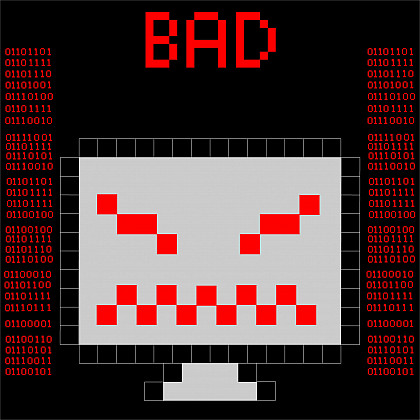 Monitor Your Mood Don't Blow a Fuse, archival inkjet print
Monitor Your Mood Don't Blow a Fuse, archival inkjet print -
 Robot President, archival inkjet print
Robot President, archival inkjet print -
 Flourishing City, archival inkjet print
Flourishing City, archival inkjet print -
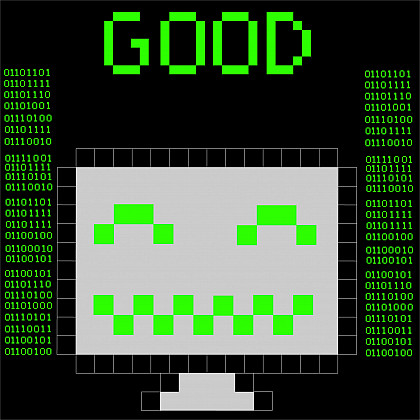 Monitor Your Mood Be Enthused, archival inkjet print
Monitor Your Mood Be Enthused, archival inkjet print -
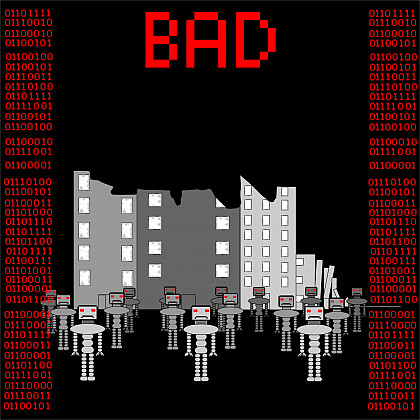 Destroyed City, archival inkjet print
Destroyed City, archival inkjet print
Photo Album: Dustin Ernest
Biography
Dustin Ernest was born on April 1, 1997 in Marion, VA. He has “studied under” his Art Teachers at Emory & Henry, like Charles Goolsby, Candace Butler, Michael Wright, and Dan Van Tassell. Ernest went to Emory & Henry College in Emory, VA, from when he graduated high school in 2015 until he graduated in 2019 with a degree in Graphic Design. In 2015, he graduated from Marion Senior High School in Marion, VA.
Ernest uses various kinds of media for his art, such as graphic design, painting, drawing, and printmaking. His senior project in Graphic Design deals with the positive and negative effects that technology has on humans and the world that we live in. He uses painting and drawing as ways to unwind, so there is no particular theme in his paintings or drawings. He tends to be more realistic in his drawings and paintings, but his graphic design work tends to be simple.
He has been making art, particularly drawing, since he was able to walk, and his family has always enjoyed his work. His oldest sibling has had an influence on him since he was little as well, because she is an artist who mostly paints in the Bristol area.
-
-

Ellen Hicks
Keep readingThe process of painting is a cathartic process for me. After experiencing a difficult loss of a loved one during my sophomore year of college, I never fully returned to a state of peace. The death of my grandfather challenged my already-wavering Christian faith. Through repressing my experience, I continued to struggle as discretely as possible without drawing attention to this change in my mindset, as being vulnerable does not come naturally to me. Eventually, this pent up energy found a much-needed outlet through creating abstract art.
The act of applying oil paint to my canvases allows me to trust my own intuition and be vulnerable. I confront suppressed feelings by painting in abstraction. Abstract art provides the opportunity to symbolize personal content without exposing every detail through recognizable subjects. I explore the complexity of my experiences and my faith through applying paint using painting methods and mediums, like walnut alkyd oil and cold wax. Some reoccurring symbols in my art are the cross, contrast in paint finishes, and layers. These symbols may relate to my faith, connection to family, or the burden of loss. The titles of these pieces provide insight to my paintings, often in the form of a date or a word that the content of the work is related to.
When I paint, I am in a conversation with each canvas. There are ups and downs, times when I need to walk away, and when I need to be vulnerable. Each canvas focuses on an emotion or experience I have repressed over the past two years. As I paint, I must confront these emotions and experiences to create a piece I can connect with. These paintings satisfy my need to address loss, faith, and loss of faith. I encourage viewers to be open to making their own connections.
-
 Dismantled, oil on canvas
Dismantled, oil on canvas -
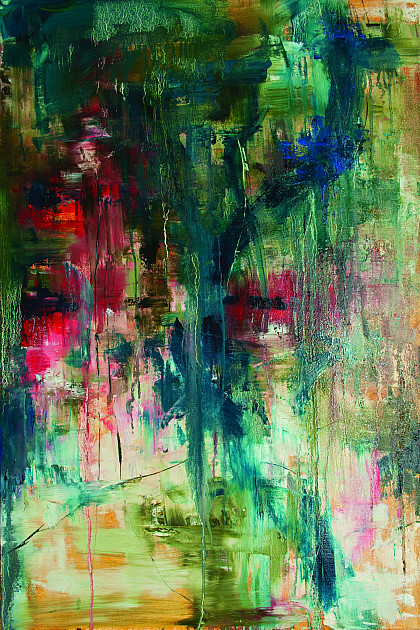 Instruction, oil on canvas
Instruction, oil on canvas -
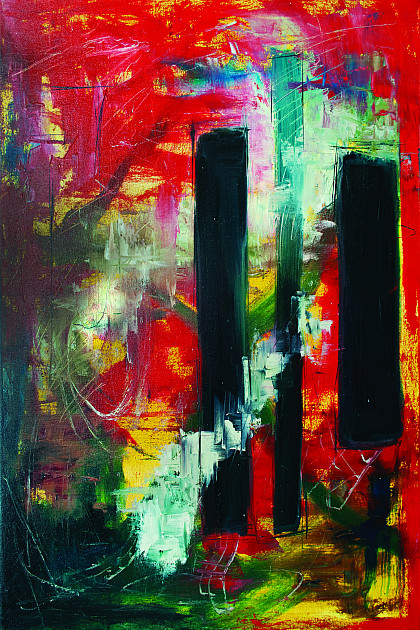 Quotidian, oil on canvas
Quotidian, oil on canvas -
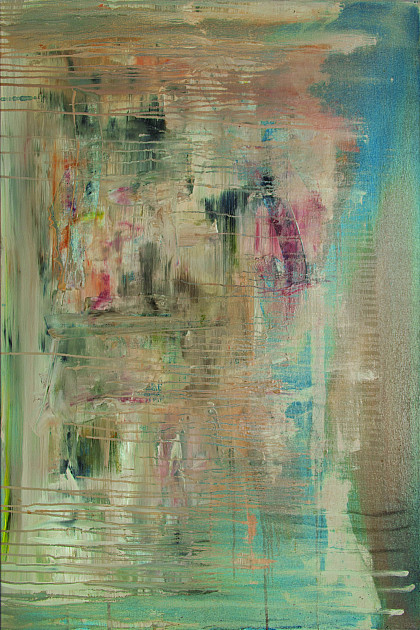 Vivication, oil on canvas
Vivication, oil on canvas -
 Last Judgment, oil on canvas
Last Judgment, oil on canvas -
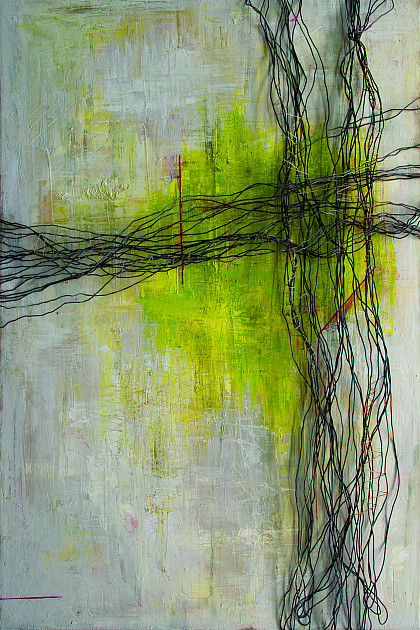 January January January, oil on canvas
January January January, oil on canvas
Photo Album: Ellen Hicks
Biography
Ellen Hicks was born in Rocky Mount, North Carolina in January, 1998. Hicks, named after her great-grandmother Lula Ellen, has held strong familial ties her entire life. The lessons she learned from her grandparents, parents, and sister shaped who she is today.
Hicks is currently a student at Emory & Henry College and is expected to graduate in May 2020 with a Bachelors of Art (B.A.) in Studio Art and a B.A. in Mass Communications. As an artist and communicator, she learned how to explain art in ways that are exciting and accessible to people with various backgrounds of artistic understanding. In 2014, Hicks traveled to San Francisco, CA to attend a National Geographic Student Expedition under the teachings of Susan Suebert, a photographer for National Geographic Traveler.
At Emory & Henry College, Hicks is a member of the school newspaper, The Whitetopper, where she serves as Website Editor, Head Photographer, and Business Manager. Hicks is a member of the Emory & Henry Honors Program, Phi Eta Sigma Honors Society, and Blue Key Honors Society.
Hicks works primary with oil paints on canvas. For the artist, abstract art provides the opportunity to symbolize personal content without exposing every detail through recognizable subjects. Reoccurring symbols in her art are crosses, contrast in paint finishes, and layers. These symbols relate to faith, connection to family, or the burden of loss.
In 2018, Hicks experienced the traumatic death of her grandfather which affected her Christian faith. Hicks’ paintings satisfy her need to face loss, faith, and loss of faith; however, she invites viewers to make their own connections to her pieces.
-
-

Theresa Mitten
Keep readingInjustice and inequality in the United States of America is common and incredibly problematic. These events occur as the result of a widening socioeconomic gap, due to the capitalist agenda of the American economy. Specifically, I’ve found this discrimination to run rampant in the American healthcare system. The injustice and inequality explored in this show can be relatable for many, even if the sensitive nature is uncomfortable to discuss. Through thought and reflection, create visual representations reflecting on the expression of personal relationships.
I create works of art that showcase my life experiences, including mistreatment due to the injustices and inequalities of a flawed economic system. My senior art exhibition, Hypermnesia is a culmination of my interactions with struggle. I am advocating for the victims of America’s crusade for abundance. The work I create is appropriated from print and three-dimensional media, that has been recontextualized for an altered perception. Works are united as a using fibrous materials to connect each rendering to my personal experiences with the healthcare industry. The viewer looks in on intimate experiences of my life, gathering sensory information through natural human curiosity.
My father’s untimely death in 2006 has inspired me to be a maker of art and a catalyst of change. Exploring these emotions and relationships have helped form a stronger foundation for visual renderings of advocacy. Without the connection of people, there is no dialog, and without dialog, facing conflict is impossible and change will never happen. As I look back on my past, my memories manifest themselves to search for truth.
-
 Rise, mixed media
Rise, mixed media -
 IM, mixed media
IM, mixed media -
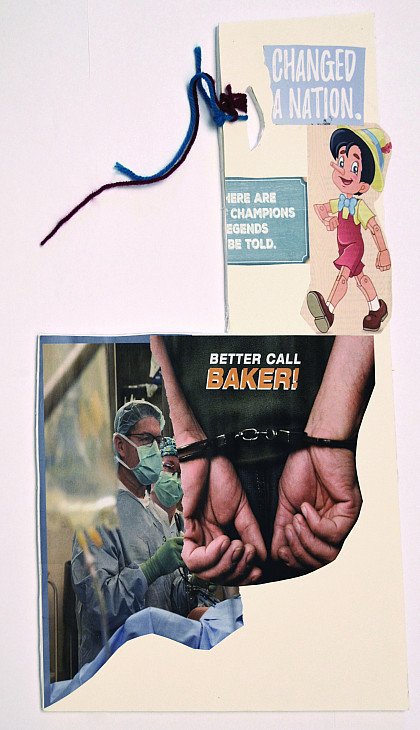 Pinocchio, mixed media
Pinocchio, mixed media -
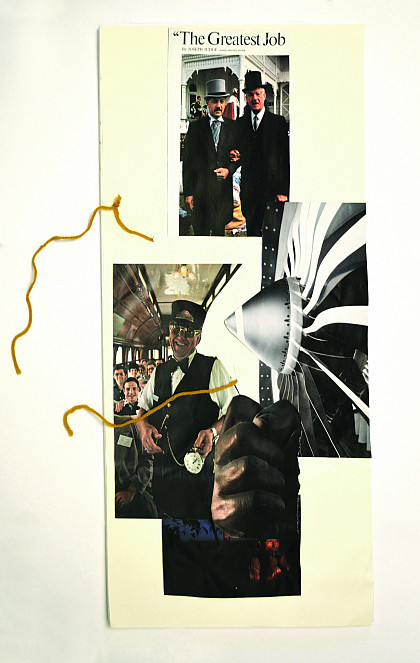 Whistleblower, mixed media
Whistleblower, mixed media -
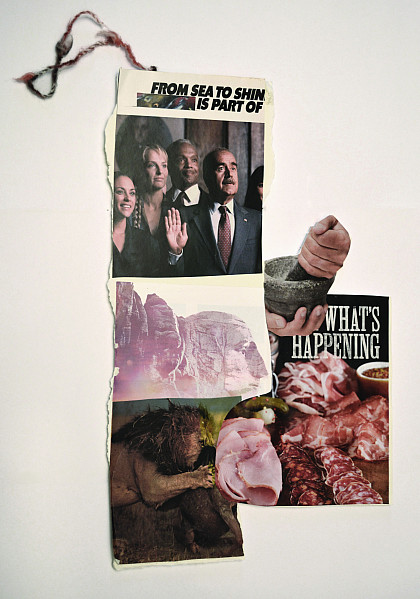 What's Happening, mixed media
What's Happening, mixed media
Photo Album: Theresa Mitten
Biography
Theresa Mitten is a mixed media artist based in Emory, VA. Born in the Appalachian region of Northeast Pennsylvania, Theresa was inspired to become an artist from hearing stories and creating renderings of her family’s heritage. Theresa’s works explore her memories and the relationships of her ancestors. In creating art, she finds unity with others. Studying under artists Maria Livrone, Charles Goolsby, Manda Remmen, and Dan Van Tassell, Theresa Mitten has established a style that incorporates mixed media and storytelling into collage works.
Theresa found her inspiration for visual storytelling through learning gallery display and large scale organization techniques at Art on Mainbased in her hometown of Pittston, PA. Her first group curated show, Faces,furthered her interest in art and museum work, resulting in a desire to learn more about her passions. While interning at the Birthplace of Country Music Museumin Bristol, VA, she created over 500 archive catalog records and helped accession the Bailey Brothers collection. Theresa serves as a Bonner Scholar at Emory & Henry College where she served on the Freedman’s Transcription Bureau leadership team. The Freedman’s Transcription Bureau transcribed historical documents and published their work in Summer 2019. Mitten’s senior exhibition titled, Hypermnesia,opened in Fall of 2019 at Emory & Henry College in the Byars Gallery. In her free time, Theresa enjoys walking with her dog, Buttercup, perusing used bookstores, exploring new genres of music, and drinking cold brew coffee.
-
-

Hannah Muller
Keep readingMeraki — when you leave a piece of yourself in your work. Soft and feminine; intense and unapproachable; minimalist and abstracted. All of these adjectives coalesce to describe my art. My work and the motivations behind why I make it is complex. As a whole, sculpting with clay is a cathartic process that reveals my inner thoughts and feelings. This body of work is specifically vulnerable as it deals with the emotional turmoil of rebuilding my identity after my dad’s unexpected death, and the raw emotion that was kept hidden from others’ view. The sculpting of the figures I create is a literal and metaphorical rebirth of who I was. It was a re-founding of my psyche, my self-image, and who I wanted to be as an individual moving forward in my new, drastically altered life.
The rounded shape of my forms also explores the complexities of femininity and the feminine form itself. Females are stereotypically thought of as soft and gentle, similarly to how one thinks of a sphere. I use this shape to represent how I was told to feel when in reality, all I felt was jagged and broken after losing my dad. All of the figures represent various states of being that I felt while grieving and subsequently healing. Standing from a distance one might see something vulnerable, yearning to comfort it. Upon further inspection however, the object you once thought to be vulnerable is in truth cold, jagged, and stand-offish towards the world, herself, and her art. Through a long and arduous journey, healing became possible, and the unthinkable evolved into reality. The abstracted forms represent healing and acceptance through the colored, rounded shapes. They exude warmth and elysian peace. Not completely soft and feminine, but also no longer intense and unapproachable.
-
 Stuck (detail), ceramic and pins
Stuck (detail), ceramic and pins -
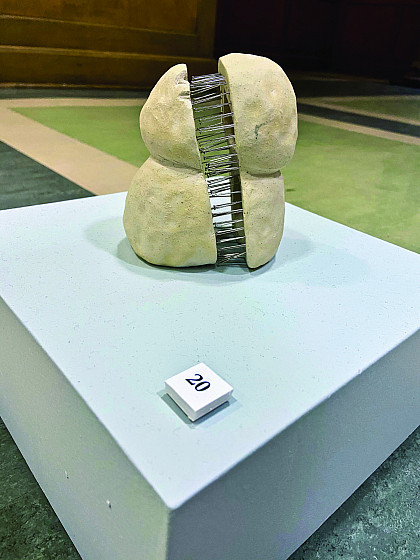 Stuck (detail 2), ceramic and pins
Stuck (detail 2), ceramic and pins -
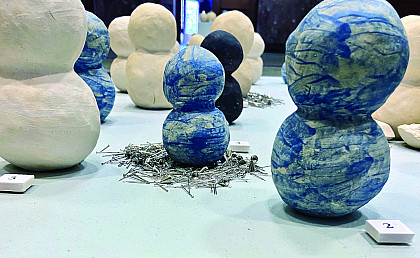 Blue 1, White 1, Blue 2 (detail), ceramic and pins
Blue 1, White 1, Blue 2 (detail), ceramic and pins -
 Black 2, White 3, Natural 10, Natural 12, Black 3 (detail), ceramic and pins
Black 2, White 3, Natural 10, Natural 12, Black 3 (detail), ceramic and pins -
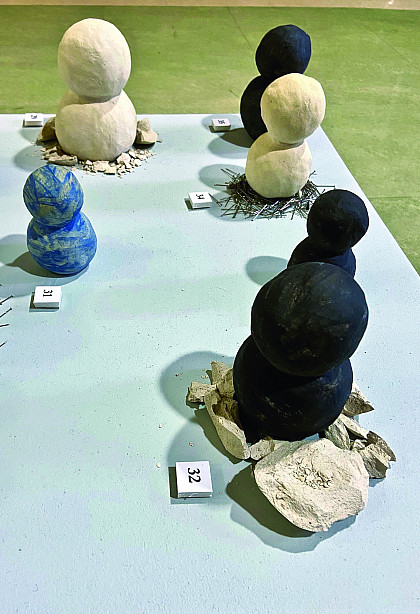 Black 4, Black 5, Blue 6, Natural 11, Natural 13 (detail), ceramic and pins
Black 4, Black 5, Blue 6, Natural 11, Natural 13 (detail), ceramic and pins -
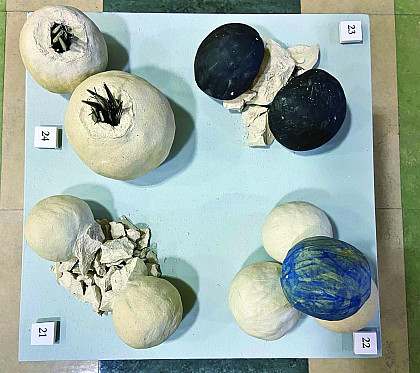 Broken Sphere 1, Sphere Group, Broken Sphere 2, Natural 9 (detail), ceramic and pins
Broken Sphere 1, Sphere Group, Broken Sphere 2, Natural 9 (detail), ceramic and pins -
 Installation detail, ceramic and pins
Installation detail, ceramic and pins
Photo Album: Hannah Muller
Biography
Growing up in a conservative area in the rural city of Hagerstown, Maryland, Hannah Muller had a set of expectations placed before her on how to act and exist as a female. This along with the unexpected death of her father at the age of fifteen drastically altered how she viewed herself as an individual. The rounded forms of her body of work and explore her personal definition and expression of femininity in the wake of her ‘new’ life. Needles are used around the figures as a representation of her mental state during the time of her grieving. Despite the spikes, her pieces are designed in size and shape to invoke a sense of vulnerability. The figures want to be held, but if one gets too close, they will get pricked by the various placement of the needles.
Hannah has worked in a professional gallery on the Emory & Henry campus for 3 years, giving her not only curatorial practice, but also the opportunity to work with and converse with a large variety of artists that have exhibited at the gallery. Continuing her collegiate education at Emory & Henry College, Hannah works towards improving and expanding her portfolio to be able to start work right out of college as an artist with her own ceramic studio.
-
-

Chelsea Snead
Keep readingTo Those In-between. As a child, I was an avid reader. Any type of printed word available was fine, but what caught my attention most were words that told a story. One of my favorite stories was a picture book version of the classic fairy tale The Bremen Town Musicians. It had the most beautiful and expressive illustrations to complement the tale. This book was a large part of the reason that I developed a love of the fantastical, magical, mythical and legendary.
To me, books and stories are windows to other worlds, and I wanted to be a part of them all. Curiosity drove me to look deeper. The saying goes that every story has two sides, but there are so many varying accounts to each myth that make me believe that there are many more. I seek to take these tales and condense them into a single concept to depict them as something that could exist. Stories and traditions exist across all cultures and bringing them to life as beasts blurs the lines between people.
The art I create taps into a childlike love of storytelling and fantasy. There is, however, a degree of darkness and uncertainty, as my art lives in places where things simultaneously exist and do not. It represents things left unsaid, in the same way that a fairy tale ends in happily ever after, yet often no one is concerned about what the “after” entails. Is there happiness to these stories, or does something dark remain unseen after the book is closed? I leave these works as an answer to those struggling in-between worlds of their own making.
-
 Raging Raiju, two-color relief print
Raging Raiju, two-color relief print -
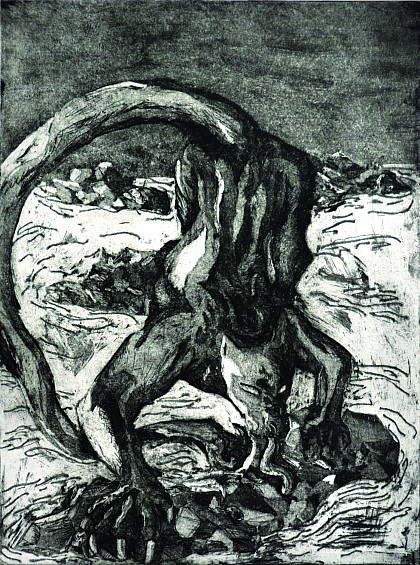 An Ahuizhotl Approaches, aquatint with etching
An Ahuizhotl Approaches, aquatint with etching -
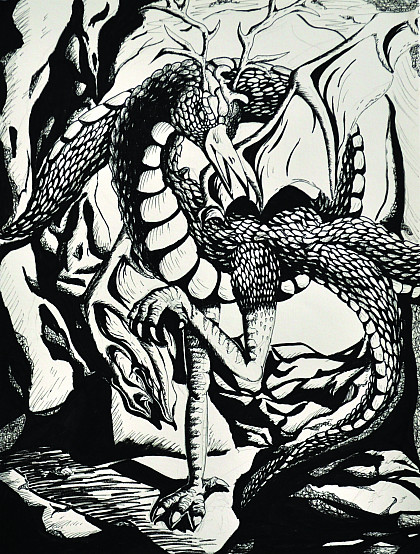 Elusive Elwidritsche, pen and ink
Elusive Elwidritsche, pen and ink -
 Entombed Inugami, pen and ink
Entombed Inugami, pen and ink -
 Knotted Naga, etching
Knotted Naga, etching -
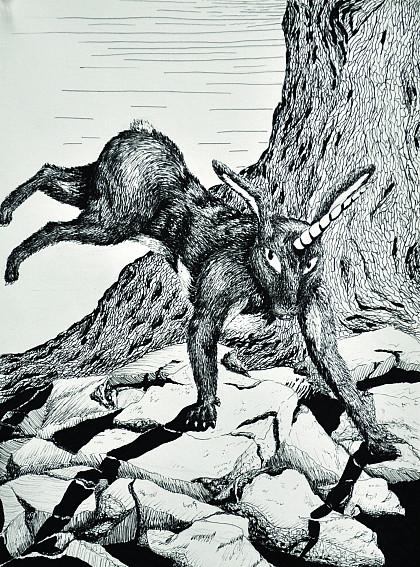 Alexander's Al miraj, pen and ink
Alexander's Al miraj, pen and ink
Photo Album: Chelsea Snead
Biography
Chelsea Snead grew up in Salem, in the Roanoke area of Virginia. The small town feel of Salem, coupled with frequent visits to her maternal grandmother’s house in the mountains gave her an appreciation for nature and an active imagination. Having been raised around animals for the entirety of her childhood, she developed a keen love and curiosity for creatures of all types. This, in addition to the artsy nature of the people around her, led to drawing a plethora of animals, both real and imagined. She also devoted a large amount of time to her schoolwork.
When she was older, she developed an interest in learning about other cultures, partly due to her paternal grandmother who was English, and partly due to the influence of reading foreign books. Books displaying fantasy elements inspired from legends were among her favorites growing up. This childlike intrigue of folklore eventually gave her the itch to travel, so in high school she visited both Italy and Greece, while in college she studied abroad in Japan.
She successfully completed her senior art show in the spring of 2020, and will be participating in a virtual art show in the near future. Outside of her art, Snead has been successful in her academic career at college, maintaining a high GPA and being a member of the Honors Program for all four years of attendance. Chelsea Snead will graduate from Emory & Henry College in May with a Bachelor’s degree in both Studio Art and Biology. Other than drawing and painting, she likes to read, sit with her dog and cat, or relax and play games during her free time.
-
Top Story
- <div class="lw_news_image"><span class="lw_item_thumb"><a href="/live/news/3041-opera-star-and-emory-henry-alumnus-michael"><picture class="lw_image"><source type="image/webp" srcset="/live/image/scale/2x/gid/7/width/345/height/225/crop/1/src_region/0,70,725,796/14217_mca-michael-austin_8.rev.1691370776.webp 2x" data-origin="responsive"/><source type="image/jpeg" srcset="/live/image/scale/2x/gid/7/width/345/height/225/crop/1/src_region/0,70,725,796/14217_mca-michael-austin_8.rev.1691370776.jpg 2x" data-origin="responsive"/><img src="/live/image/gid/7/width/345/height/225/crop/1/src_region/0,70,725,796/14217_mca-michael-austin_8.rev.1691370776.jpg" alt="Michael Austin '75" width="345" height="225" srcset="/live/image/scale/2x/gid/7/width/345/height/225/crop/1/src_region/0,70,725,796/14217_mca-michael-austin_8.rev.1691370776.jpg 2x" data-max-w="725" data-max-h="726" loading="lazy" data-optimized="true"/></picture></a></span></div><div class="lw_widget_text"><h4 class="lw_news_headline"><a href="/live/news/3041-opera-star-and-emory-henry-alumnus-michael">Opera Star and Emory & Henry Alumnus, Michael Austin, Highlights Fall Season at McGlothlin Center for the Arts</a></h4><div class="lw_news_summary"><p> A performance by renowned international opera star Michael Austin highlights the fall season of the McGlothlin Center for the Arts at Emory & Henry College.</p><a href="/live/news/3041-opera-star-and-emory-henry-alumnus-michael" class="link-with-arrow gold">Keep reading</a></div></div>
- <div class="lw_news_image"><span class="lw_item_thumb"><a href="/live/news/3040-mca-gallery-presents-three-exhibitions-during-fall"><picture class="lw_image"><source type="image/webp" srcset="/live/image/scale/2x/gid/7/width/345/height/225/crop/1/src_region/0,0,1800,1800/14215_Batcheller_Gretchen_ProblemsGainCurrency_2021_web.rev.1691369928.webp 2x, /live/image/scale/3x/gid/7/width/345/height/225/crop/1/src_region/0,0,1800,1800/14215_Batcheller_Gretchen_ProblemsGainCurrency_2021_web.rev.1691369928.webp 3x" data-origin="responsive"/><source type="image/jpeg" srcset="/live/image/scale/2x/gid/7/width/345/height/225/crop/1/src_region/0,0,1800,1800/14215_Batcheller_Gretchen_ProblemsGainCurrency_2021_web.rev.1691369928.jpg 2x, /live/image/scale/3x/gid/7/width/345/height/225/crop/1/src_region/0,0,1800,1800/14215_Batcheller_Gretchen_ProblemsGainCurrency_2021_web.rev.1691369928.jpg 3x" data-origin="responsive"/><img src="/live/image/gid/7/width/345/height/225/crop/1/src_region/0,0,1800,1800/14215_Batcheller_Gretchen_ProblemsGainCurrency_2021_web.rev.1691369928.jpg" alt="Gretchen Batcheller, Problems Gain Currency 2021" width="345" height="225" srcset="/live/image/scale/2x/gid/7/width/345/height/225/crop/1/src_region/0,0,1800,1800/14215_Batcheller_Gretchen_ProblemsGainCurrency_2021_web.rev.1691369928.jpg 2x, /live/image/scale/3x/gid/7/width/345/height/225/crop/1/src_region/0,0,1800,1800/14215_Batcheller_Gretchen_ProblemsGainCurrency_2021_web.rev.1691369928.jpg 3x" data-max-w="1800" data-max-h="1800" loading="lazy" data-optimized="true"/></picture></a></span></div><div class="lw_widget_text"><h4 class="lw_news_headline"><a href="/live/news/3040-mca-gallery-presents-three-exhibitions-during-fall">MCA Gallery Presents Three Exhibitions During Fall</a></h4><div class="lw_news_summary"><p> The works of artists Lori Vrba, Gretchen Batcheller, and Nicole Santiago and John Lee will be featured in three separate exhibitions this fall at the McGlothlin Center Art Gallery.</p><a href="/live/news/3040-mca-gallery-presents-three-exhibitions-during-fall" class="link-with-arrow gold">Keep reading</a></div></div>

